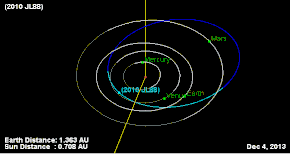|
2010 JL88
2010 JL88 is an unnumbered asteroid, classified as a near-Earth object of the Apollo group, approximately 19 meters in diameter.[2] It was first observed by the Siding Spring Survey, Australia, on 15 May 2010. It is known to be the fastest rotator with an unambiguous period solution, having an exceptionally rapid rotation period of less than 25 seconds.[4][8] On May 17, 2010, it passed 0.00257 AU (384,000 km) from Earth.[4] It is on the lower of the Sentry Risk Table.[1] Earth impact possibility2010 JL88 has an Earth minimum orbit intersection distance of 0.45 Lunar Distances[9] However, it only has a 1 in 1,449,000 (0.000069%) chance of impacting into Earth sometime after 2049.[1] Even if it did impact, 2010 JL88 is so small that it would simply disintegrate in a manner similar to the Chelyabinsk meteor.[10] RotationThe asteroid was found to have a rapid rotation by the Magdalena Ridge Observatory's 2.4-meter telescope. It rotates at an extremely rapid rate of 24.5 seconds. 2010 JL88 is the second fastest natural rotating object discovered in the Solar System,[8] after 2014 RC, which has a period of 16 seconds but still an uncertain period solution. See alsoReferences
External links
|
||||||||||||||||||||||||||||||||||||||||||||||||||||||||
